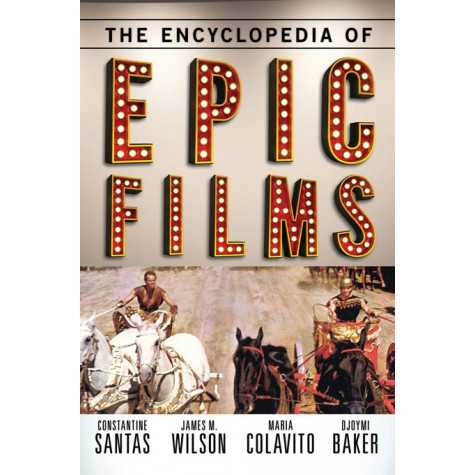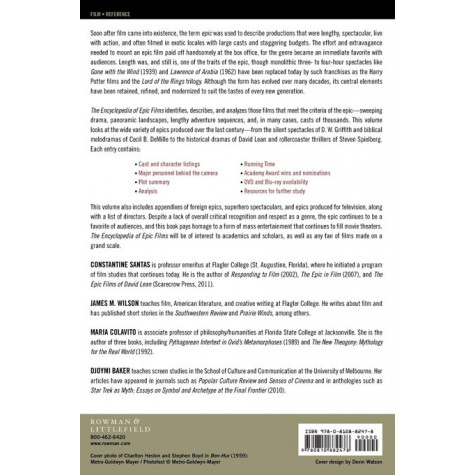The Encyclopedia of Epic Films
- Author:
- Pages: 712
- Year: 2014
- Book Code: Hardcover
- Availability: In Stock
- Publisher: Rowman & Littlefield
-
₹14,995.00
Soon after film came into existence, the term epic was used to describe productions that were lengthy, spectacular, live with action, and often filmed in exotic locales with large casts and staggering budgets. The effort and extravagance needed to mount an epic film paid off handsomely at the box office, for the genre became an immediate favorite with audiences. Epic films survived the tribulations of two world wars and the Depression and have retained the basic characteristics of size and glamour for more than a hundred years. Length was, and still is, one of the traits of the epic, though monolithic three- to four-hour spectacles like Gone with the Wind (1939) and Lawrence of Arabia (1962) have been replaced today by such franchises as the Harry Potter films and the Lord of the Rings trilogy. Although the form has evolved during many decades of existence, its central elements have been retained, refined, and modernized to suit the tastes of every new generation.
The Encyclopedia of Epic Films identifies, describes, and analyzes those films that meet the criteria of the epic—sweeping drama, panoramic landscapes, lengthy adventure sequences, and, in many cases, casts of thousands. This volume looks at the wide variety of epics produced over the last century—from the silent spectacles of D. W. Griffith and biblical melodramas of Cecil B. DeMille to the historical dramas of David Lean and rollercoaster thrillers of Steven Spielberg. Each entry contains:
- Major personnel behind the camera, including directors and screenwriters
- Cast and character listings
- Plot summary
- Analysis
- Academy Award wins and nominations
- DVD and Blu-ray availability
- Resources for further study
This volume also includes appendixes of foreign epics, superhero spectaculars, and epics produced for television, along with a list of all the directors in the book. Despite a lack of overall critical recognition and respect as a genre, the epic remains a favorite of audiences, and this book pays homage to a form of mass entertainment that continues to fill movie theaters. The Encyclopedia of Epic Films will be of interest to academics and scholars, as well as any fan of films made on a grand scale.
About the Authors
Constantine Santas is professor emeritus at Flagler College (St. Augustine, Florida), where he initiated a program of film studies that continues today. He is the author of Responding to Film (2002), The Epic in Film (2007), and The Epic Films of David Lean (Scarecrow Press, 2011).
James M. Wilson teaches film, American literature, and creative writing at Flagler College. He teaches and writes about film and has published short stories in the Southwestern Review and Prairie Winds, among others.
Maria Colavito is associate professor of philosophy/humanities at Florida State College at Jacksonville. She is the author of three books, including The Pythagorean Intertext in Ovid’s Metamorphoses (1989) and The New Theogony: Mythology for the Real World (1992).
Djoymi Baker teaches screen studies in the School of Culture and Communication at the University of Melbourne. Her articles have appeared in journals such as Popular Culture Review and Senses of Cinema and in anthologies such as Star Trek as Myth: Essays on Symbol and Archetype at the Final Frontier (2010).
Review
An epic film, according to this publication, is one that is lengthy, spectacular, live with action, and often filmed in exotic locales with large casts and staggering budgets. The films are sometimes three to four hours long. This volume features a 'Films A to Z' section and four appendixes. Entries contain cast and character listings, 'major personnel behind the camera,' plot summaries, analysis, running time, Academy Award wins and nominations, DVD/Blu-ray availability, and resources for further study. The appendixes cover foreign epics, superhero spectaculars, and television epics. . . .Many interesting facts are presented. . . .Also notable are the instances in which this volume explores both original films and their remakes. Two King Kong films, two Cleopatra films, and two Ten Commandments films (1923 and 1956; both directed by Cecil B. DeMille) are covered. Film series such as The Godfather, the Christopher Reeve Superman films, The Lord of the Rings series, and the Sam Raimi Spider-Man films are also examined. Stanley Kubrick's majestic 2001: A Space Odyssey is described as having vision, dazzling sets, visual style, beautiful music score sequences, and mystery. These are definitive ingredients for a classic epic film. This book will be a useful addition to college and university libraries, especially those supporting film programs. Summing Up: Recommended. Lower-division undergraduates through researchers/faculty. — Choice
[T]his beneficial guide provides a historical perspective along with ideas for general viewers and cineastes. — Library Journal
To borrow a famously ambiguous definition, it appears that one knows what an epic is when one sees it. The introduction to this eclectic encyclopedia—of a genre possessing a less distinct character than, say, musicals, documentaries, or mysteries—eschews a single definition of epic film. Rather, it traces the origins of epic to the writings of Homer and other ancients on to American film, especially through the 1960s. In the process, it describes epic films’ evolving characteristics, relationship to archetypes, and response to changes in popular taste. Organizational structure implies the clearest distinction within the genre, relegating superhero and franchise epics (such as Batman, Lord of the Rings, Star Wars) to an appendix preceding appendixes for foreign-language epics, made-for-TV epics, and directors and their works. . . .The alphabetical organization by film title accommodates readily acknowledged epics, such as Lawrence of Arabia, Gone with the Wind, and Cleopatra, along with others that the label fits more loosely, for example, Elmer Gantry and Mr. Smith Goes to Washington. Entries include credits and substantial plot summaries, with less attention to critical response. Most include a brief bibliography of pertinent works. The index lists personal names and film titles. This work, like other genre-specific film encyclopedias, will please film buffs. — Booklist
This single-volume encyclopedia written by four authors (including film scholar Constantine Santas) is one of the first reference works dedicated solely to the epic film genre. The authors in the introduction provide background information, including a definition of what an epic is, and briefly describe how they selected the films discussed. Organized in alphabetic order by title, this specialized encyclopedia contains well over 100 individual film entries. . . .The entries are quite thorough, usually in the neighborhood of seven to ten paragraphs, and almost every film has a notes and bibliography section for further reading. . . .The book does an admirable job of trying to include a variety of epics from famous titles such as Ben-Hur, Gone with the Wind, and Lawrence of Arabia to more modern fare such as Lincoln and Avatar. This work is good starting point for undergraduate students and film lovers to learn more about specific American epics or expand their knowledge of science fiction or action movies that one might not immediately associate with the epic genre. The encyclopedia’s primary focus is with American movies. Foreign epics are addressed mainly within one appendix. . . .Ultimately, the main strength of this encyclopedia is the easy-to-read yet lengthy plot summaries, analysis, and bibliographies. This original reference work is recommended for public libraries and academic libraries with a film studies program. — American Reference Books Annual
There’s nothing a die hard movie fan loves more than digging into a big fat reference book about their favorite subject, especially when it’s well-written by knowledgeable authors. Although the Cinema Surgeon General warns us regularly of the dangers of overindulging on certain fattening flicks, what movie fan doesn’t love occasionally gorging themselves on a big, fat, spectacular epic? After all, they're Hollywood’s equivalent of a pizza loaded with everything. Most of us hold a few certain epics near and dear to our hearts. Like clockwork, I watch The Ten Commandments every Easter, and the entire Godfather trilogy annually rings-in my summer break (since I’m a teacher in the real world). Whenever I’m laid-out with the flu, The Good, the Bad and the Ugly and The Great Escape are as comforting as Ny-Quil. All those films, and just about every other movie one would define as epic, are included in The Encyclopedia of Epic Films. . . .[T]his 700 page volume is comprehensive. No one’s likely to say to themselves, 'How could they leave out (insert title here)?' The book does a decent job defining what constitutes an epic film, not just its length, but its scope, budget, imagery and timeless story elements. Everything is well-written and there’s no disputing these authors’ knowledge. Additionally, each entry includes extensive cast & crew credits, Oscar/Golden Globe wins and nominations, its availability on DVD/Blu-Ray and bibliographical resources for those inclined to read further. — Moviepilot
A thorough and weighty book, The Encyclopedia of Epic Films . . . is recommended for film connoisseurs and movie-lovers alike. — St. Augustine Record
The most epic films of all time! This is clear when open The Encyclopedia of Epic Films and encounter a huge list of films. Written by Constantine Santas, James M. Wilson, Maria Colavito and Djoymi Baker, the book is comprehensive and includes a list of more than 250 films. Each film is discussed separately, and that makes this a very complete work. — FilmTotaal
What constitutes an epic film? That is part of what this encyclopaedia attempts to answer. The epic is often associated with historical epics set in the Biblical, Roman or Ancient Egyptian periods. But within the pages of the book this is expanded and there are as many surprising exclusions as inclusions. But of course these Ancient World classics are given prominence and are even sporting the cover. . . .The book is set out as an A-Z of epics with several pages given over to each of the approximate 250 films covered (the book is an epic tome itself at 712 pages). At the end of the analysis of each film there are even footnotes and credits for the main cast and crew, running time and DVD/Blu-ray availability etc. — Filmwerk
Constantine Santas continues to be one of our best scholars on the epic film. . . .The Encyclopedia of Epic Films provides a great service to films scholars by encouraging them to think about and categorize familiar films and in new ways. . . .This book invites serious consideration of epic films may well inspire new research and college courses on the topic. — Journal of American Culture
Tags: The Encyclopedia of Epic Films, Constantine Santas, James M. Wilson, Maria Colavito, Djoymi Baker, 9780810882478, Rowman & Littlefield


